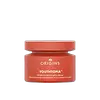What's inside
What's inside
 Key Ingredients
Key Ingredients

 Benefits
Benefits

 Concerns
Concerns

 Ingredients Side-by-side
Ingredients Side-by-side

Water
Skin ConditioningPropanediol
SolventGlycerin
HumectantLimnanthes Alba Seed Oil
Skin ConditioningBetaine
HumectantBehenyl Alcohol
EmollientCeramide AP
Skin Conditioning1,2-Hexanediol
Skin ConditioningCarbomer
Emulsion StabilisingTromethamine
BufferingJojoba Esters
EmollientArachidyl Alcohol
EmollientGlyceryl Caprylate
EmollientButylene Glycol
HumectantEthylhexylglycerin
Skin ConditioningDisodium EDTA
Arachidyl Glucoside
EmulsifyingMentha Arvensis Leaf Extract
MaskingParfum
MaskingHydrolyzed Hyaluronic Acid
HumectantMalachite Extract
AntioxidantAureobasidium Pullulans Ferment
Skin ConditioningTocopherol
AntioxidantUndaria Pinnatifida Extract
Skin ConditioningWater, Propanediol, Glycerin, Limnanthes Alba Seed Oil, Betaine, Behenyl Alcohol, Ceramide AP, 1,2-Hexanediol, Carbomer, Tromethamine, Jojoba Esters, Arachidyl Alcohol, Glyceryl Caprylate, Butylene Glycol, Ethylhexylglycerin, Disodium EDTA, Arachidyl Glucoside, Mentha Arvensis Leaf Extract, Parfum, Hydrolyzed Hyaluronic Acid, Malachite Extract, Aureobasidium Pullulans Ferment, Tocopherol, Undaria Pinnatifida Extract
Water
Skin ConditioningGlycerin
HumectantSqualane
EmollientCaprylic/Capric Triglyceride
MaskingIsoamyl Laurate
EmollientButyrospermum Parkii Butter
Skin ConditioningCetearyl Olivate
Pyrus Malus Seed Oil
EmollientMalus Domestica Fruit Cell Culture Extract
Skin ConditioningPyrus Malus Fiber
AbrasiveZingiber Officinale Root Extract
MaskingLaminaria Digitata Extract
Skin ProtectingLaminaria Saccharina Extract
Skin ProtectingLactobacillus Ferment
Skin ConditioningSodium Hyaluronate
HumectantCaffeine
Skin ConditioningOryzanol
Skin ConditioningTocopherol
AntioxidantGlycine Soja Oil
EmollientAcetyl Hexapeptide-8
HumectantEthylhexylglycerin
Skin ConditioningLecithin
EmollientButylene Glycol
HumectantResveratrol
AntioxidantSorbitan Olivate
EmulsifyingChamomilla Recutita Flower Oil
MaskingMentha Piperita Oil
MaskingCoriandrum Sativum Fruit Oil
MaskingCitrus Nobilis Peel Oil
MaskingMimosa Tenuiflora Leaf Extract
Skin ProtectingCitrus Aurantium Dulcis Peel Oil
MaskingCitrus Aurantium Bergamia Fruit Oil
MaskingCitrus Limon Peel Oil
MaskingRosa Damascena Flower Extract
MaskingRosa Damascena Flower Oil
MaskingMichelia Alba Flower Oil
MaskingCopaifera Officinalis Resin
MaskingFerula Galbaniflua Resin Oil
AntimicrobialJasminum Sambac Flower Extract
MaskingRicinus Communis Seed Oil
MaskingPelargonium Graveolens Flower Oil
MaskingLinalool
PerfumingCitral
PerfumingLimonene
PerfumingCitronellol
PerfumingGeraniol
PerfumingPEG-40 Stearate
EmulsifyingXanthan Gum
EmulsifyingCarbomer
Emulsion StabilisingPhenoxyethanol
PreservativePotassium Sorbate
PreservativeMica
Cosmetic ColorantCI 77891
Cosmetic ColorantWater, Glycerin, Squalane, Caprylic/Capric Triglyceride, Isoamyl Laurate, Butyrospermum Parkii Butter, Cetearyl Olivate, Pyrus Malus Seed Oil, Malus Domestica Fruit Cell Culture Extract, Pyrus Malus Fiber, Zingiber Officinale Root Extract, Laminaria Digitata Extract, Laminaria Saccharina Extract, Lactobacillus Ferment, Sodium Hyaluronate, Caffeine, Oryzanol, Tocopherol, Glycine Soja Oil, Acetyl Hexapeptide-8, Ethylhexylglycerin, Lecithin, Butylene Glycol, Resveratrol, Sorbitan Olivate, Chamomilla Recutita Flower Oil, Mentha Piperita Oil, Coriandrum Sativum Fruit Oil, Citrus Nobilis Peel Oil, Mimosa Tenuiflora Leaf Extract, Citrus Aurantium Dulcis Peel Oil, Citrus Aurantium Bergamia Fruit Oil, Citrus Limon Peel Oil, Rosa Damascena Flower Extract, Rosa Damascena Flower Oil, Michelia Alba Flower Oil, Copaifera Officinalis Resin, Ferula Galbaniflua Resin Oil, Jasminum Sambac Flower Extract, Ricinus Communis Seed Oil, Pelargonium Graveolens Flower Oil, Linalool, Citral, Limonene, Citronellol, Geraniol, PEG-40 Stearate, Xanthan Gum, Carbomer, Phenoxyethanol, Potassium Sorbate, Mica, CI 77891
 Reviews
Reviews

Ingredients Explained
These ingredients are found in both products.
Ingredients higher up in an ingredient list are typically present in a larger amount.
Butylene Glycol (or BG) is used within cosmetic products for a few different reasons:
Overall, Butylene Glycol is a safe and well-rounded ingredient that works well with other ingredients.
Though this ingredient works well with most skin types, some people with sensitive skin may experience a reaction such as allergic rashes, closed comedones, or itchiness.
Learn more about Butylene GlycolCarbomer is a polymer of acrylic acid. Its main role is to create a gel consistency.
A high amount of carbomer can cause pilling or balling up of products. Don't worry, most products contain 1% or less of carbomer.
Ethylhexylglycerin (we can't pronounce this either) is commonly used as a preservative and skin softener. It is derived from glyceryl.
You might see Ethylhexylglycerin often paired with other preservatives such as phenoxyethanol. Ethylhexylglycerin has been found to increase the effectiveness of these other preservatives.
Glycerin is already naturally found in your skin. It helps moisturize and protect your skin.
A study from 2016 found glycerin to be more effective as a humectant than AHAs and hyaluronic acid.
As a humectant, it helps the skin stay hydrated by pulling moisture to your skin. The low molecular weight of glycerin allows it to pull moisture into the deeper layers of your skin.
Hydrated skin improves your skin barrier; Your skin barrier helps protect against irritants and bacteria.
Glycerin has also been found to have antimicrobial and antiviral properties. Due to these properties, glycerin is often used in wound and burn treatments.
In cosmetics, glycerin is usually derived from plants such as soybean or palm. However, it can also be sourced from animals, such as tallow or animal fat.
This ingredient is organic, colorless, odorless, and non-toxic.
Glycerin is the name for this ingredient in American English. British English uses Glycerol/Glycerine.
Learn more about GlycerinTocopherol (also known as Vitamin E) is a common antioxidant used to help protect the skin from free-radicals and strengthen the skin barrier. It's also fat soluble - this means our skin is great at absorbing it.
Vitamin E also helps keep your natural skin lipids healthy. Your lipid skin barrier naturally consists of lipids, ceramides, and fatty acids. Vitamin E offers extra protection for your skin’s lipid barrier, keeping your skin healthy and nourished.
Another benefit is a bit of UV protection. Vitamin E helps reduce the damage caused by UVB rays. (It should not replace your sunscreen). Combining it with Vitamin C can decrease sunburned cells and hyperpigmentation after UV exposure.
You might have noticed Vitamin E + C often paired together. This is because it is great at stabilizing Vitamin C. Using the two together helps increase the effectiveness of both ingredients.
There are often claims that Vitamin E can reduce/prevent scarring, but these claims haven't been confirmed by scientific research.
Learn more about TocopherolWater. It's the most common cosmetic ingredient of all. You'll usually see it at the top of ingredient lists, meaning that it makes up the largest part of the product.
So why is it so popular? Water most often acts as a solvent - this means that it helps dissolve other ingredients into the formulation.
You'll also recognize water as that liquid we all need to stay alive. If you see this, drink a glass of water. Stay hydrated!
Learn more about Water